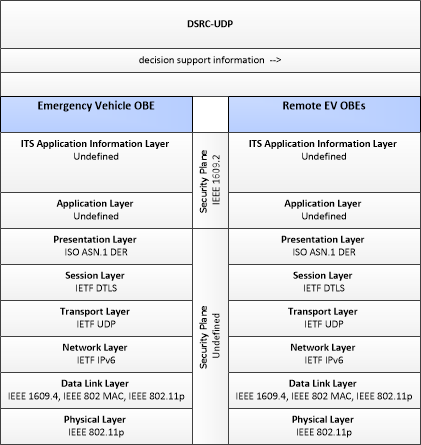Link Type: Short Range Wireless
Emergency Vehicle OBE --> Remote EV OBEs:
decision support information
This triple is bi-directional. See also
Remote EV OBEs --> Emergency Vehicle OBE: decision support information
Definitions
decision support information (Information Flow): Information provided to support effective and safe incident response, including local traffic, road, and weather conditions, hazardous material information, and the current status of resources (including vehicles, other equipment, supplies) that have been allocated to an incident.
Emergency Vehicle OBE (Source Physical Object): The Emergency Vehicle On-Board Equipment (OBE) resides in an emergency vehicle and provides the processing, storage, and communications functions that support public safety-related connected vehicle applications. It represents a range of vehicles including those operated by police, fire, and emergency medical services. In addition, it represents other incident response vehicles including towing and recovery vehicles and freeway service patrols. It includes two-way communications to support coordinated response to emergencies. In CVRIA, a separate 'Vehicle OBE' physical object supports the general V2V and V2I safety applications and other applications that apply to all vehicles, including emergency vehicles. The Emergency Vehicle OBE supplements these general capabilities with capabilities that are specific to emergency vehicles.
Remote EV OBEs (Destination Physical Object): This represents on-board equipment on remote emergency (e.g., law enforcement, fire, EMS, towing and recovery) vehicles. It provides a source and destination for ITS information transfers between emergency vehicles. These information transfers allow information to be shared between emergency vehicles arriving, or involved at, an incident. Vehicle to vehicle communications at incident locations facilitates incident coordination and personal safety.
Included In
This Information Flow is in the following Applications:
- Incident Scene Pre-Arrival Staging Guidance for Emergency Responders
- Incident Scene Work Zone Alerts for Drivers and Workers
This Information Flow is in the following Application Objects:
Communication Diagrams
The communication diagram(s) can be viewed in SVG or PNG format and the current format is SVG. Switch to PNG format.
Characteristics
Architectural:
| Characteristic | Value |
|---|---|
| Time Context | Recent |
| Spatial Context | Regional |
| Acknowledgement | True |
| Cardinality | Unicast |
| Initiator | Source |
Security
This information flow triple is in the following applications with the following security levels.
| Information Flow Security | |||||
|---|---|---|---|---|---|
| Application | Confidentiality | Integrity | Availability | ||
| Basis | Basis | Basis | |||
| Incident Scene Work Zone Alerts for Drivers and Workers | Moderate | Moderate | Moderate | ||
| This information could be of interest to a malicious individual who is attempting to determine the best way to accomplish a crime. As such it would be best to not make it easily accessible. | If this is compromised, it could send inaccurate information to a vehicle which could lead to inappropriate actions in the incident area. | A delay in reporting this may cause a delay in response or inability for an Emergency Vehicle and its personnel to properly respond to the incident. | |||
